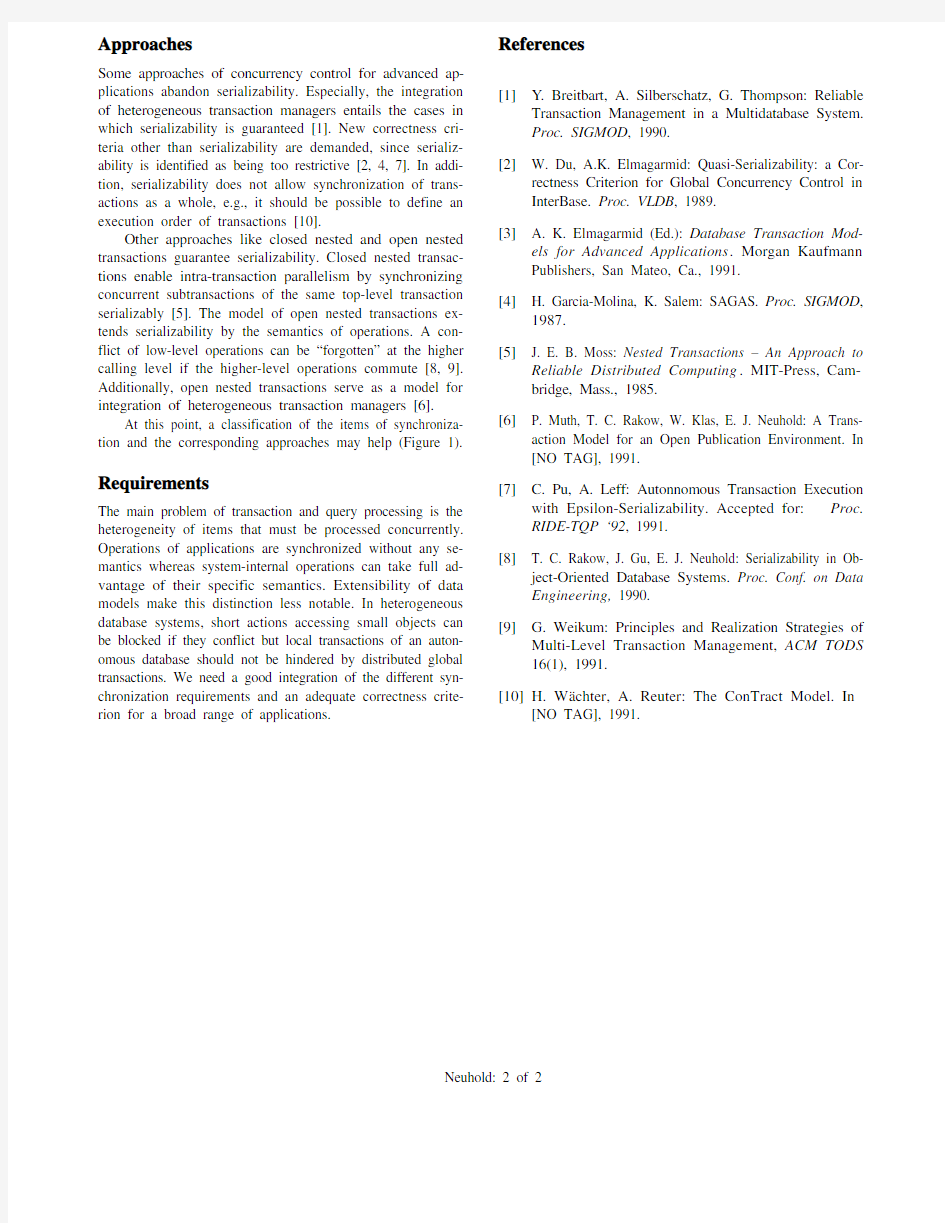Position Statement to the Panel


Panel on “Issues on Concurrent Transaction and Query Processing”
Panelists:
Yuri Breitbart (Kentucky University), Erich J. Neuhold (Panel Chair, GMD-IPSI), Calton Pu (Columbia University), Hans-J?rg Schek (ETH Zürich), N.N.
Position Statement to the Panel
Erich J. Neuhold and Thomas C. Rakow
GMD
Integrated Publication and Information Systems Institute (IPSI)
Dolivostra?e 15, D-W-6100 Darmstadt, Germany
e-mail: {neuhold, rakow}@darmstadt.gmd.de
Introduction
Today’s database systems control the execution of concur-rent transactions by ensuring the serializability condition. Serializability is easy to understand and allows to reason about a transaction independently of others. The application programmer only needs to specify the statements which constitute a single transaction. However, operations at the system-internal level are synchronized differently. For ex-ample, operations on B+trees are synchronized by applying specific tree locking protocols. In addition, some relational database systems guarantee atomicity of operations on tu-ples with short locks at the page level.
The appearance of non-conventional applications like CAD/CAM, office automation, and electronic publishing to-gether with the need to integrate distributed, heterogeneous and even autonomous database systems imposes some fur-ther requirements on transaction and query processing [3]. For example, how can long-lasting transactions be synchro-nized since they tend to decrease heavily the amount of pos-sible parallelism? How can the restrictions of serializability be relaxed? How can locks on large objects be released earli-er? How can we integrate different transaction managers?
Items of Synchronization Approach
(1) (atomic) actions of various transactions flat transactions with ACID–properties
(2) (divisible) subtransactions of the same transaction closed nested transactions
(3) (divisible) subtransactions of various transactions open nested transactions
(4) transactions of the same application parallel programming language, operating system,
transaction dependencies
(5) transactions of different application parallel programming language, operating system
Figure1: Classification of Synchronization Items.
Neuhold: 1 of 2
Approaches
Some approaches of concurrency control for advanced ap-plications abandon serializability. Especially, the integration of heterogeneous transaction managers entails the cases in which serializability is guaranteed [1]. New correctness cri-teria other than serializability are demanded, since serializ-ability is identified as being too restrictive [2, 4, 7]. In addi-tion, serializability does not allow synchronization of trans-actions as a whole, e.g., it should be possible to define an execution order of transactions [10].
Other approaches like closed nested and open nested transactions guarantee serializability. Closed nested transac-tions enable intra-transaction parallelism by synchronizing concurrent subtransactions of the same top-level transaction serializably [5]. The model of open nested transactions ex-tends serializability by the semantics of operations. A con-flict of low-level operations can be “forgotten” at the higher calling level if the higher-level operations commute [8, 9]. Additionally, open nested transactions serve as a model for integration of heterogeneous transaction managers [6].
At this point, a classification of the items of synchroniza-tion and the corresponding approaches may help (Figure 1). Requirements
The main problem of transaction and query processing is the heterogeneity of items that must be processed concurrently. Operations of applications are synchronized without any se-mantics whereas system-internal operations can take full ad-vantage of their specific semantics. Extensibility of data models make this distinction less notable. In heterogeneous database systems, short actions accessing small objects can be blocked if they conflict but local transactions of an auton-omous database should not be hindered by distributed global transactions. We need a good integration of the different syn-chronization requirements and an adequate correctness crite-rion for a broad range of applications.References
[1]Y. Breitbart, A. Silberschatz, G. Thompson: Reliable
Transaction Management in a Multidatabase System.
Proc. SIGMOD, 1990.
[2]W. Du, A.K. Elmagarmid: Quasi-Serializability: a Cor-
rectness Criterion for Global Concurrency Control in InterBase. Proc. VLDB, 1989.
[3] A. K. Elmagarmid (Ed.): Database Transaction Mod-
els for Advanced Applications. Morgan Kaufmann Publishers, San Mateo, Ca., 1991.
[4]H. Garcia-Molina, K. Salem: SAGAS. Proc. SIGMOD,
1987.
[5]J. E. B. Moss: Nested Transactions – An Approach to
Reliable Distributed Computing. MIT-Press, Cam-bridge, Mass., 1985.
[6]P. Muth, T. C. Rakow, W. Klas, E. J. Neuhold: A Trans-
action Model for an Open Publication Environment. In [NO TAG], 1991.
[7] C. Pu, A. Leff: Autonnomous Transaction Execution
with Epsilon-Serializability. Accepted for: Proc.
RIDE-TQP ‘92, 1991.
[8]T. C. Rakow, J. Gu, E. J. Neuhold: Serializability in Ob-
ject-Oriented Database Systems. Proc. Conf. on Data Engineering, 1990.
[9]G. Weikum: Principles and Realization Strategies of
Multi-Level Transaction Management, ACM TODS 16(1), 1991.
[10]H. W?chter, A. Reuter: The ConTract Model. In
[NO TAG], 1991.
Neuhold: 2 of 2
